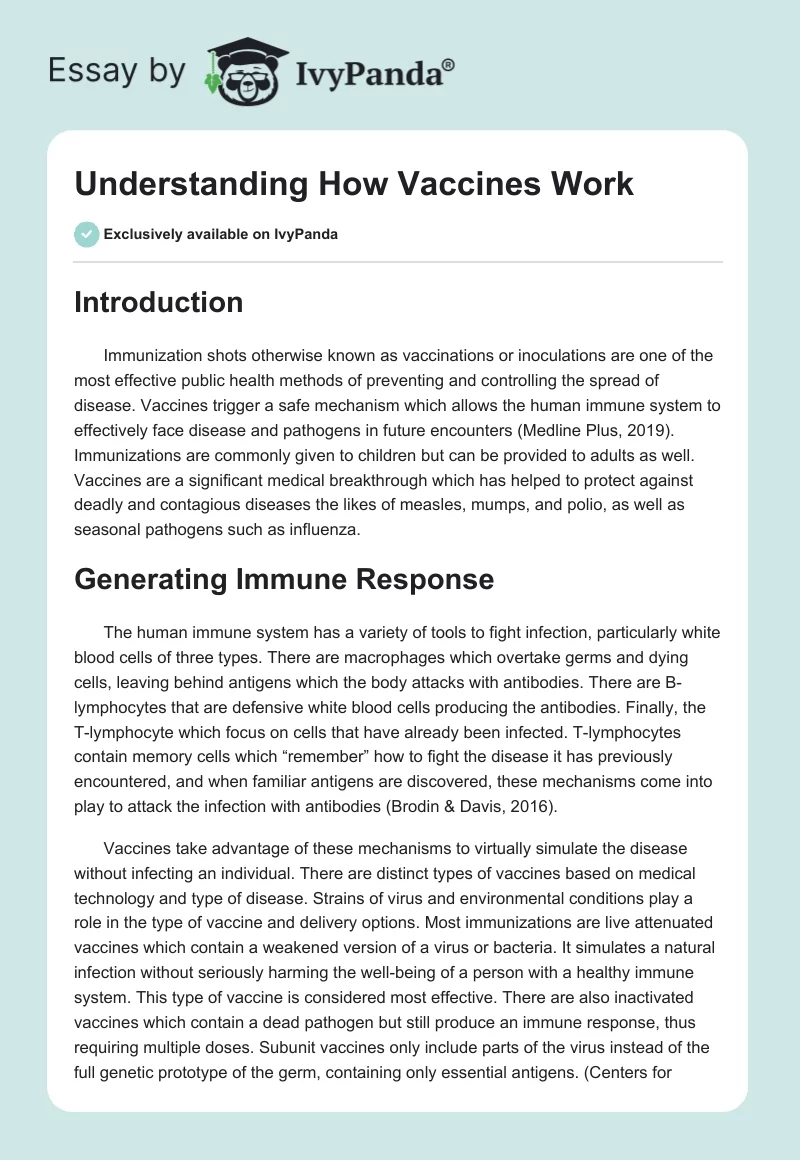Introduction
Immunization shots otherwise known as vaccinations or inoculations are one of the most effective public health methods of preventing and controlling the spread of disease. Vaccines trigger a safe mechanism which allows the human immune system to effectively face disease and pathogens in future encounters (Medline Plus, 2019). Immunizations are commonly given to children but can be provided to adults as well. Vaccines are a significant medical breakthrough which has helped to protect against deadly and contagious diseases the likes of measles, mumps, and polio, as well as seasonal pathogens such as influenza.
Generating Immune Response
The human immune system has a variety of tools to fight infection, particularly white blood cells of three types. There are macrophages which overtake germs and dying cells, leaving behind antigens which the body attacks with antibodies. There are B-lymphocytes that are defensive white blood cells producing the antibodies. Finally, the T-lymphocyte which focus on cells that have already been infected. T-lymphocytes contain memory cells which “remember” how to fight the disease it has previously encountered, and when familiar antigens are discovered, these mechanisms come into play to attack the infection with antibodies (Brodin & Davis, 2016).
Vaccines take advantage of these mechanisms to virtually simulate the disease without infecting an individual. There are distinct types of vaccines based on medical technology and type of disease. Strains of virus and environmental conditions play a role in the type of vaccine and delivery options. Most immunizations are live attenuated vaccines which contain a weakened version of a virus or bacteria. It simulates a natural infection without seriously harming the well-being of a person with a healthy immune system. This type of vaccine is considered most effective. There are also inactivated vaccines which contain a dead pathogen but still produce an immune response, thus requiring multiple doses. Subunit vaccines only include parts of the virus instead of the full genetic prototype of the germ, containing only essential antigens. (Centers for Disease Control and Prevention, 2018b). Influenza vaccines come in an inactivated (IIV), live attenuated (LAIV), and recombinant (RIV) forms. There is no specific preference of one over another and they are usually delivered in trivalent or quadrivalent flu shots, which include the influenza A (H1N1) virus, influenza A (H3N2) virus, and one or two influenza B viruses which are chosen based on lineage and season (Centers for Disease Control and Prevention, 2018a).
When a vaccine is injected, it results in an initial reaction of local pain, triggering a response from the body. Lymph nodes which contain antigens and carrying cells arrive at the site. Antibody response varies depending on recognition by B-cell receptors and interactions with T cells. The first step is extrafollicular where B-cells proliferate into plasma cells leading to short-lived reactions since it is a vaccine. The next and most critical step is the germinal center reaction where activated antigen-specific B-cells interact with T cells and attracted by antigen-bearing follicular dendric cells to form a specialized unit, the germinal center (GC). This reproduces the B-cells in a somatic hypermutation process, creating high-affinity clones. The B-cells switch to antibody production eventually maturing into either plasma or memory cells. A similar process occurs in T-cells. It is key for a vaccine to activate innate immunity at the site that stimulates the activation of production and cloning of the immune cells (Siegrist & Lambert, 2016). All types of vaccines cause T-lymphocyte production in the body and imitate the infection, leading to a “memory” being stored in the immune system, significantly aiding the body next time it encounters a pathogen of this type.
Changing Effectiveness
A number of factors contribute to the changing effectiveness of the influenza vaccine year over year. A common explanation for a statistically low effectiveness vaccine is due to an antigenic mismatch. Influenza and other similar pathogens rapidly evolve to escape immunity based on environmental, human, and medicinal factors. Furthermore, mutations may occur during manufacturing which further exacerbates the issue. Effectiveness may also change based on individual response and age. Based on the theory of original antigenic sin (OAS), it is suggested that influenza antigens encountered in childhood, permanently influence the organism’s response. Therefore, cross-reactivity to the influenza vaccination in healthy adults depends strongly on previous vaccination and infection history (Lewnard & Cobey, 2018). Health agencies are faced with a significant challenge of creating a universal vaccine which closely matches that year’s seasonal influenza. It is an aspect of the vaccine design that requires careful study of influenza strands and observation of the population over time. Although mathematic modeling and empirical research are used, the effectiveness of the vaccine may change among individuals and over seasons due to rapidly evolving strains (Centers for Disease Control and Prevention, 2018c).
Conclusion
Vaccines are an effective and safe method of protecting from and combatting against disease. By simulating a pathogen, they are able to trigger a response from the human immune system which makes it less vulnerable to the condition in the future. By doing this on a mass scale, herd immunity can be developed to prevent outbreaks. However, some viral infections such as influenza are constantly evolving and require a continuous update of the vaccination to protect the organism.
References
Brodin, P., & Davis, M. M. (2016). Human immune system variation. Nature Reviews Immunology, 17(1), 21-29. doi:10.1038/nri.2016.125
Centers for Disease Control and Prevention. (2018a). Key facts about seasonal flu vaccine. Web.
Centers for Disease Control and Prevention. (2018b). Understanding how vaccines work. Web.
Centers for Disease Control and Prevention. (2018c). Vaccine effectiveness: How well do the flu vaccines work?. Web.
Lewnard, J. A., & Cobey, S. (2018). Immune history and influenza vaccine effectiveness. Vaccines, 6(2), 28. Web.
MedlinePlus. (2019). Immunization. Web.
Siegrist, C.-A., & Lambert, P.-H. (2016). How vaccines work. In B. R. Bloom & P.-H. Lambert (Eds.), The vaccine book (2nd ed.) (pp. 33-42). Amsterdam, Netherlands: Elsevier.


